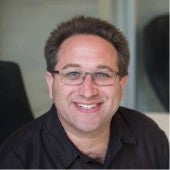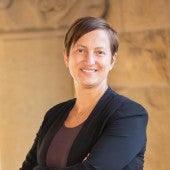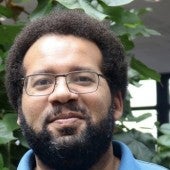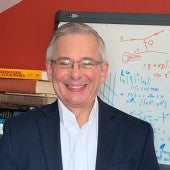

University of Texas at Austin
Scott Aaronson is the Schlumberger Chair of Computer Science at the University of Texas at Austin, and founding director of its Quantum Information Center. He received his bachelor's from Cornell University and his PhD from UC Berkeley. Before coming to UT Austin, he spent nine years as a professor in Electrical Engineering and Computer Science at MIT. Aaronson's research in theoretical computer science has focused mainly on the capabilities and limits of quantum computers. His first book, Quantum Computing Since Democritus, was published in 2013 by Cambridge University Press. He received the National Science Foundation’s Alan T. Waterman Award, the United States PECASE Award, the Tomassoni-Chisesi Prize in Physics, and the ACM Prize in Computing, and is a Fellow of the ACM.
Abstract
Rice University
Ramesh pursues key materials physics and technological problems in complex multifunctional oxides. Using conducting oxides, he solved the 30-year enigma of polarization fatigue in ferroelectrics. He pioneered research into manganites coining the term, Colossal Magnetoresistive (CMR) Oxides. His work on multiferroics demonstrated electric field control of ferromagnetism, a critical step towards ultralow power memory and logic elements. His extensive publications on the synthesis and materials physics of complex oxides are highly cited (over 100,000 citations, H-factor =150). He is a fellow of APS, AAAS & MRS and an elected member of the U.S. National Academy of Engineering, a Foreign member of the Royal Society of London, the Indian National Science Academy and a Fellow of the American Academy for Arts and Sciences. His awards include the Humboldt Senior Scientist Prize, the APS Adler Lectureship and McGroddy New Materials Prize, the TMS Bardeen Prize and the IUPAP Magnetism Prize and Neel Medal and the Europhysics Prize in 2022. He was recognized as a Thomson-Reuters Citation Laureate in Physics for his work on multiferroics. He served as the Founding Director of the successful Department of Energy SunShot Initiative in the Obama administration, envisioning and coordinating the R&D funding of the U.S. Solar Program, spearheading the reduction in the cost of Solar Energy. He also served as the Deputy Director of Oak Ridge National Laboratory and the Associate Lab Director at LBNL. Most recently, he served on the Biden-Harris Transition Team for Energy. He is also a co-founder of Kepler Computing, which is focused on low power computing using ferroelectrics. Since 15 August, he is the Vice President for Research at Rice University.
Abstract
University of Texas at San Antonio
Kathryn (Katie) Mayer is an Associate Professor in the Department of Physics and Astronomy at the University of Texas at San Antonio, where she has been a faculty member since 2014. Her group studies metallic nanoparticles and their biomedical applications. Katie is originally from Cleveland, Ohio and earned her bachelor’s and Ph.D. in Physics at Rice University, where she was a member of the Hafner Lab. After that she did postdoctoral research in Chemistry at UT Austin and at Tufts University before joining UTSA’s faculty as a member of the Biophysics group.
Abstract
Stanford University
Risa Wechsler is the Director of the Kavli Institute for Particle Astrophysics and Cosmology and a Professor of Physics at Stanford Univeristy and of Particle Physics and Astrophysics at the SLAC National Accelerator Laboratory. She is a cosmologist whose work combines numerical simulations and modeling with data from large galaxy surveys to understand the formation of cosmic structure, the physics of galaxy formation, and the nature of dark energy and dark matter. She has played a leadership role in surveys that map the universe, including the Dark Energy Survey, the Dark Energy Spectroscopic Instrument, and the Vera Rubin Observatory's Legacy Survey of Space and Time. Wechsler is a Fellow of the American Physical Society and the American Association for the Advancement of Science. She received her PhD in physics at the University of California Santa Cruz in 2001 and received 2022 Distinguished Alumni Award from the University. She is passionate about broadening access to physics and astronomy and engaging the public with scientific discovery and has written about and discussed science in numerous public venues, including TED, Teen Vogue, and the BBC.
Abstract
University of Texas at Austin
Peter Onyisi is an associate professor in experimental particle physics at the University of Texas at Austin, where his research focuses on understanding the highest energy human-created particle collisions at the Large Hadron Collider in Geneva, Switzerland. His work spans a broad range of topics, from the details of proton structure to the interactions of the heaviest known fundamental particles, the top quark and the Higgs boson. He received his PhD from Cornell and was a Fermi postdoctoral fellow at the University of Chicago.
Abstract
Columbia University
Bill Zajc is the I.I. Rabi Professor of Physics at Columbia University. He received his B.S. from the California Institute of Technology in 1975 and his Ph.D. from the University of California, Berkeley in 1982. After a postdoctoral and assistant professor position at the University of Pennsylvania, he moved to Columbia in 1987. His research has focused on high energy nuclear collisions (relativistic heavy ion physics), mostly at Brookhaven National Laboratory (BNL) in Upton, New York. From 1997 to 2006 he was the spokesperson (scientific leader) of the PHENIX experiment at BNL’s Relativistic Heavy Ion Collider (RHIC) during the phase of initial RHIC discoveries, including the discovery of the “perfect liquid” behavior of the quark-gluon plasma. Zajc is a Fellow of the American Physical Society and the American Association for the Advancement of Science, and recipient of the 2014 Bonner Prize in Nuclear Physics.
